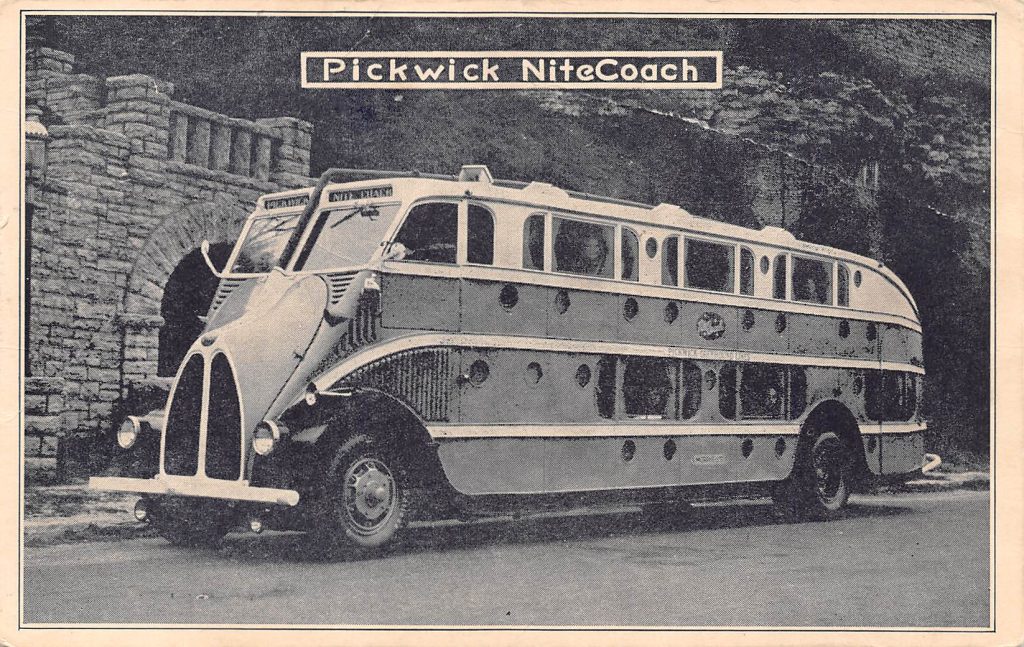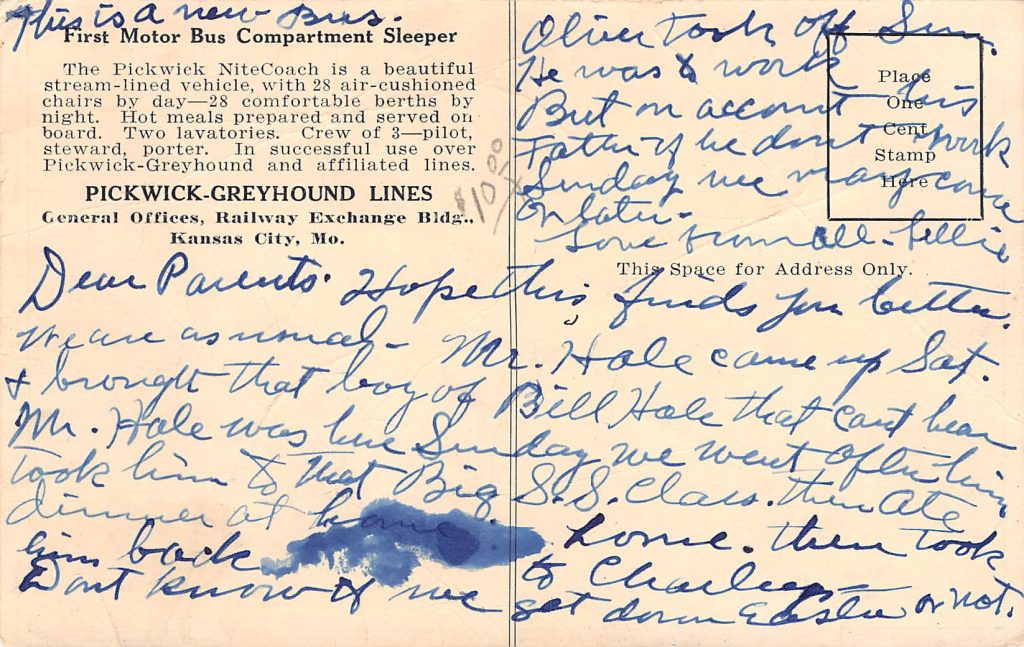Editor’s Staff
The Pickwick NiteCoach

From the title, we may think this story comes straight from a Dickens novel. Not so! The surname Pickwick did however originate in Wiltshire, a shire in south-western England, where the Pickwicks were lords of a manor. There are several “Pickwick” spelling variations that include: Pyckwick, Pykewick, Pickwyck, and Pyckwyck.
A chronology of the Pickwicks would be an amusing tale for Levi Pickwick, who was likely a son, or grandson, of the Life Peer was convicted of a crime in the early 19th century and was among the English prisoners sent to Australia in 1824. John Pickwick (perhaps Levi’s grandson or, more likely, a great-nephew) left the ancestral home and was the first to arrive in North America in 1871. Noteworthy as John may have become due to his business affairs in Ontario, he had nothing to do with the Pickwick NiteCoach.
* * *
To examine the nite-coach we need to look westward. The first two decades of the 20th century witnessed growth beyond comprehension in the American west. In many ways the wild-west was still wild, but ever-so-slowly, civilization was chasing the bad-boys into the hills. Shortly after 1905, yet before the start of World War One, Charles F. Wren, a young electrician from Bethany, Missouri, left home for Arizona and was engaged in a Prescott mining operation and a tire-manufacturing company. Neither of Wren’s businesses succeeded but he managed to come away from his failures with a fortune. In 1915 Wren met Dwight E. Austin. Austin’s work and Wren’s money were the perfect combination for a new manufacturing concern devoted to livery and freight vehicles, especially long-cars and buses.
The corporate machinations of Wren and his dealings with at least five business partners is long and complicated – how in only ten years one man could find so many opportunities to make and lose money – is laughable. One of which was a partnership with a man named A. L. Hayes. Hayes had been involved in a mining operation in Mexico, but abandoned everything and fled across the border at San Diego at the onset of the Mexican civil war to preserve his life. As a means of livelihood, he purchased an old truck and started a motor-stage company which serviced the San Diego area.
* * *
The Pickwick Theatre on Fourth Avenue, between Broadway and C Street in San Diego was built in 1904 by Louis J. Wilde, later a mayor of San Diego. The structure served as a vaudeville stage, opera house, then in 1922 switched to a motion picture and general performance venue featuring Paramount movies and troupes of traveling shows. It had 825-seats.
The Pickwick lasted only twenty years. It was demolished during a land-boom in 1926. However two very successful livery companies, Hayes included, moved into the new Pickwick Hotel where they maintained administrative and ticket offices under the name Pickwick Stages.
* * *
When Wren got involved, the Pickwick Corporation was organized under the laws of California as a holding company to consolidate Wren’s various business enterprises. By the late-1920s, Pickwick had expanded to the north and east by buying smaller companies and enlarging each company’s route maps.
When Wren met Dwight E. Austin, the circumstances made it possible for the Pickwick Stages to combine with livery and newly acquired freight companies and further expansion was inevitable. Austin became the manager and vice president of the newly formed Nite Coach Company.
A transportation website described Dwight E. Austin (1897-1960) as a natural born engineer who excelled at his profession despite the fact that his formal education ended at the eighth grade. In 1915 he joined his father and brother in the formation of an automobile repair business where he developed a knack for working with wood and metal which led the firm into the body building business. After the 1922 sale of his father’s business, Dwight was subsequently hired by the Pickwick Stages who appointed him designer and superintendent of it body works in 1923.
In mid-1928 Wren’s new enterprise introduced the revolutionary Pickwick Nite Coach, it carried 26-passengers. The success of the 1928 Nite Coach triggered a similar 53-passenger day coach, the Pickwick Duplex, in 1930. In 1932, yet another totally new sleeper coach came into service that featured aerodynamic breadbox styling.
A local newspaper reported: The stage is the first of its kind ever constructed and is unique in that it is equipped with a buffet with a steam table in which hot meals will be prepared en route, a complete lavatory, smoking compartment, observation, and parlor room. A steward is to be on duty at all times. The stage was built at the Los Angeles shops of the Pickwick Stage Company and is one of two of its kind which are to be put in service between San Francisco and Los Angeles.
The usual travel time between the two cities was cut to fourteen hours, forty-five minutes. The Pickwick Nite-Coach, operated by a company named for a theater in San Diego won national acclaim.

* * *
Postcard History Online Magazine thanks Gary and Peggy Spengler of Frederica, Delaware, for submitting the postcard for this article.
Thanks for a very interesting article. A few years ago we spent several days in Allentown Pennsylvania to attend one of the paper/postcard shows at the fairgrounds. There is a great museum in Allentown called America on Wheels that has a model of one of the Pickwick coaches. The model really caught our attention and the next day at the postcard show we were able to find a Pickwick Coach postcard.
Hard to imagine a buffet set up on a bus! Wonder how the meals compared to those served in railroad dining cars of the era.
Interesting! Loved learning about the Pickwick story!
Thank you for such an interesting article. As a retired flight attendant – I enjoyed the history of the bus compared to airplanes! Well done.
re Pickwick – Does anyone know the position and dates of Ed Thompson?